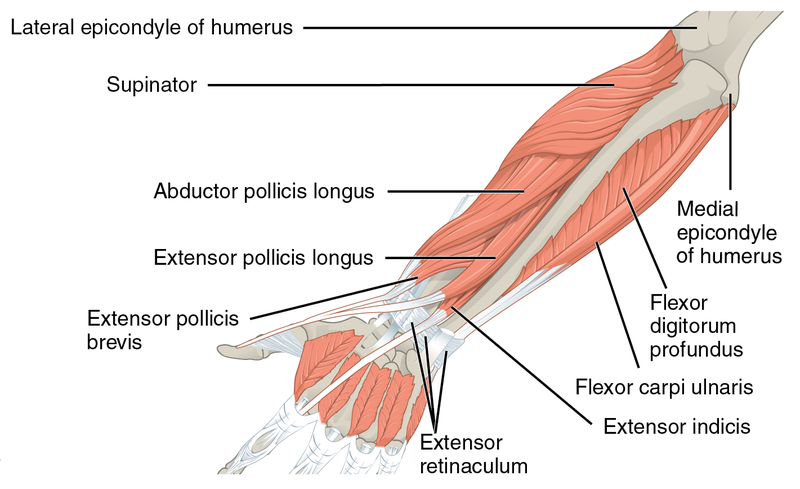Sweater Finger Sign: Difference between revisions
No edit summary |
No edit summary |
||
| Line 5: | Line 5: | ||
The sweater finger sign also called Jersey Test is used to confirm the rupture or the integrity of the Flexor Digitorum Profundus (FDP) Tendon. It occurs most often to the ring finger <ref>Harvey W. Overview of Wrist and Hand Orthopaedic Special Tests. Home Health Care Management & Practice. 23rd ed. 2011.</ref>. | The sweater finger sign also called Jersey Test is used to confirm the rupture or the integrity of the Flexor Digitorum Profundus (FDP) Tendon. It occurs most often to the ring finger <ref>Harvey W. Overview of Wrist and Hand Orthopaedic Special Tests. Home Health Care Management & Practice. 23rd ed. 2011.</ref>. | ||
[[File:Muscles that move the Forearm.png|center| | [[File:Muscles that move the Forearm.png|center|frame]] | ||
== Clinically Relevant Anatomy == | == Clinically Relevant Anatomy == | ||
| Line 27: | Line 27: | ||
=== ''Interpretation of results'' === | === ''Interpretation of results'' === | ||
The sweater finger sign is said to be positive when the finger is not bent | The sweater finger sign is said to be positive when the finger is not bent; when there is a loss of flexion at DIP of one of the fingers. | ||
== '''Clinical Indication''' == | == '''Clinical Indication''' == | ||
Revision as of 07:39, 1 November 2020
Purpose[edit | edit source]
The sweater finger sign also called Jersey Test is used to confirm the rupture or the integrity of the Flexor Digitorum Profundus (FDP) Tendon. It occurs most often to the ring finger [1].
Clinically Relevant Anatomy[edit | edit source]
Flexor DigitorumPofundus is a fusiform muscle located deep within the anterior (flexor) compartment of the forearm [2]. The tendons of the flexor digitorum profndus insert into the base of the distal phalanges of the index, middle, ring, and little fingers. As the tendons of the FDP arise at or below the wrist joint, they allow a power grip by the contraction of the muscle [3].
Technique[edit | edit source]
The following steps are taken to confirm if the sign is positive or not: [4]
Step 1. The therapist holds the patients' MCP and PIP in full extension.
Step 2. Then the patient is asked to flex at the DIP or make a fist
Step 3. The PIP must be held in full extension to isolate FDP function
Step 4. If the FDP is intact, the patient will be able to flex at the DIP
Patient's position[edit | edit source]
The patient's position while tested should be sitting position
Interpretation of results[edit | edit source]
The sweater finger sign is said to be positive when the finger is not bent; when there is a loss of flexion at DIP of one of the fingers.
Clinical Indication[edit | edit source]
The Jersey test is indicated in the diagnosis of the Flexor digitorum profundus injury [5].
Resources[edit | edit source]
References[edit | edit source]
- ↑ Harvey W. Overview of Wrist and Hand Orthopaedic Special Tests. Home Health Care Management & Practice. 23rd ed. 2011.
- ↑ Flexor digitorum profundus muscle. Available from: https://www.kenhub.com/en/library/anatomy/flexor-digitorum-profundus-muscle ( Accessed, 31 October 2020)
- ↑ Lung BE, Burns B. Anatomy, Shoulder and Upper Limb, Hand Flexor Digitorum Profundus Muscle. InStatPearls [Internet] 2019 Feb 10. StatPearls Publishing.
- ↑ Demystifying the Hand Exam. Available from: https://www.nuemblog.com/blog/2018/4/9/hand-exam (Accessed, 31 October 2020)
- ↑ Han Exam. Available from: https://fpnotebook.com/ortho/exam/HndExm.htm ( Accessed, 31 October 2020)
- ↑ Alfred University Health and Human Performance. Sweater Finger Sign. Available from: http://https://www.youtube.com/watch?v=cEaMYr0NuWk [last accessed 31/10/2020]
- ↑ Dr. Nabil Ebraheim. Jersey Finger - Everything You Need To Know. Available from:https://www.youtube.com/watch?v=rwy9gfN0K_Q [ last accessed 31/10/2020]







